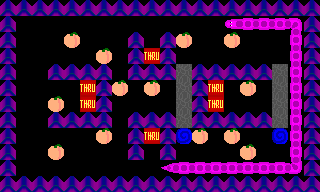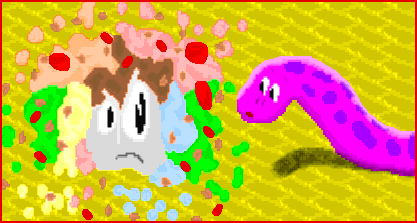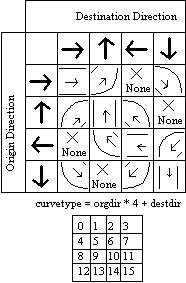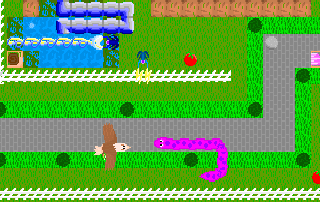  History of Nibbler
History of Nibbler
 I have already stated that I have
always liked old-school puzzle games, including Lode Runner and Adventures of
Lolo. These games go so far on so little. The question inevitably came to me:
"can you do it, too?" I have already stated that I have
always liked old-school puzzle games, including Lode Runner and Adventures of
Lolo. These games go so far on so little. The question inevitably came to me:
"can you do it, too?"
  I
had made games before, but never anything commercially viable. My reasoning for
this was simple: no resources. It's just a hobby, right? I
had made games before, but never anything commercially viable. My reasoning for
this was simple: no resources. It's just a hobby, right?
  But
then I got a grand idea when slogging through my reactor kinetics homework in
college. I decided (silly me) to put the idea down on paper. It came out to be
several pages long. But
then I got a grand idea when slogging through my reactor kinetics homework in
college. I decided (silly me) to put the idea down on paper. It came out to be
several pages long.
  In
only five hours, I had come up with virtually every aspect of the game
as it would look years in the future. Shortly after the preliminary design, I
decided I would actually pull it off. In
only five hours, I had come up with virtually every aspect of the game
as it would look years in the future. Shortly after the preliminary design, I
decided I would actually pull it off.
  What Makes the Game Different?
What Makes the Game Different?
 A computer game must have a niche
that makes it stand out. It can be anything--graphics, sound, gameplay,
sensationalism, unique controls, you name it. Since the genre of this game was
not new, I knew I had to think of something special for it to gain any
attention. A computer game must have a niche
that makes it stand out. It can be anything--graphics, sound, gameplay,
sensationalism, unique controls, you name it. Since the genre of this game was
not new, I knew I had to think of something special for it to gain any
attention.
 What's more, what kind of work
would it take to make the game, especially with a new feature that made it
stand out in the crowd? Obviously, the work I did on the prototype game from
high school would not be enough. No; I would have to do something very radical. What's more, what kind of work
would it take to make the game, especially with a new feature that made it
stand out in the crowd? Obviously, the work I did on the prototype game from
high school would not be enough. No; I would have to do something very radical.
  Soon
afterwards, I developed the radical feature, called "substitution matrix
technology." This is an algorithm that drives the visual display of the snake
body in real-time. In addition to good graphics, it would have good animation
and a frame rate of 60 FPS. Now that I had my feature and my design, no turning
back was possible. Soon
afterwards, I developed the radical feature, called "substitution matrix
technology." This is an algorithm that drives the visual display of the snake
body in real-time. In addition to good graphics, it would have good animation
and a frame rate of 60 FPS. Now that I had my feature and my design, no turning
back was possible.
  The DOS version of Nibbler
The DOS version of Nibbler
 A rather significant problem
about inventing your own drawing algorithm is the fact that little or no
support for your programming and design tasks can be found. I would need to not
only design the game, but also develop the engine itself. A rather significant problem
about inventing your own drawing algorithm is the fact that little or no
support for your programming and design tasks can be found. I would need to not
only design the game, but also develop the engine itself.
 Perhaps I got carried away, or
perhaps it was necessary work. It's a fact: no preexisting material went into
Nibbler's code. It took many years to get it done, since I was still in college
most of the time and could never give the project my undivided attention. Perhaps I got carried away, or
perhaps it was necessary work. It's a fact: no preexisting material went into
Nibbler's code. It took many years to get it done, since I was still in college
most of the time and could never give the project my undivided attention.
  The
graphics were all drawn by Yours Truly, too. I know it's a common assumption
that many computer programming types aren't the greatest artists. Well, I'll
have to assume it's true in a general sense, since I had no issues creating my
own artwork. I had an advantage in being the artist: no breakdown in
communication between the artist and the programmer. The
graphics were all drawn by Yours Truly, too. I know it's a common assumption
that many computer programming types aren't the greatest artists. Well, I'll
have to assume it's true in a general sense, since I had no issues creating my
own artwork. I had an advantage in being the artist: no breakdown in
communication between the artist and the programmer.
 I liked the result. It was a fun
DOS game. Campy at times, but still fun. The original goal of the project had
been accomplished. I liked the result. It was a fun
DOS game. Campy at times, but still fun. The original goal of the project had
been accomplished.
  Lack of Satisfaction
Lack of Satisfaction
 In 2003, I posted the DOS Beta
Version and got feedback from beta testers. That's when I knew I had to
increase the resolution, get better sound, make better software tools if
necessary, and focus much more on the quality of the game than the game engine
development. In 2003, I posted the DOS Beta
Version and got feedback from beta testers. That's when I knew I had to
increase the resolution, get better sound, make better software tools if
necessary, and focus much more on the quality of the game than the game engine
development.
 What really happened was this: I
made the decision to move the project from the "hobby" category to the
"professional" category. The constructive feedback from my testers had the
consequence of forcing me to choose between acceptance as an amateur or
striving to become a real pro. I chose the latter. It is possible that my work
at Lilly in the Complaints department at the time (where customer satisfaction
was a primary issue) had something to do with my choice. What really happened was this: I
made the decision to move the project from the "hobby" category to the
"professional" category. The constructive feedback from my testers had the
consequence of forcing me to choose between acceptance as an amateur or
striving to become a real pro. I chose the latter. It is possible that my work
at Lilly in the Complaints department at the time (where customer satisfaction
was a primary issue) had something to do with my choice.
 Ever since, I have worked toward
a second beta version that would run on a Win32 platform. Fortunately, I had a
mind to write code such that cross-platform portability could happen with
relative ease. Ever since, I have worked toward
a second beta version that would run on a Win32 platform. Fortunately, I had a
mind to write code such that cross-platform portability could happen with
relative ease.
 As of this writing, the only
unanswered question is how to bring the game to market. I know for certain that
Nibbler entertains a very broad audience. Still, the game industry has rapidly
transitioned from a diverse free-for-all amongst a plethora of developers to a
contest between big development studios, making it harder to get footholds in
the game development world. Only time will tell where the game will go from
here. As of this writing, the only
unanswered question is how to bring the game to market. I know for certain that
Nibbler entertains a very broad audience. Still, the game industry has rapidly
transitioned from a diverse free-for-all amongst a plethora of developers to a
contest between big development studios, making it harder to get footholds in
the game development world. Only time will tell where the game will go from
here.
  The Nibbler Editor, NibEdit
The Nibbler Editor, NibEdit
  The
level editor for Nibbler is a simple, grid-based application. It is easy to use
and self-documented whenever possible. Help can be found at the Official
Nibbler Site. See the links below for more information. The
level editor for Nibbler is a simple, grid-based application. It is easy to use
and self-documented whenever possible. Help can be found at the Official
Nibbler Site. See the links below for more information.
 More
Details About the Nibbler Project More
Details About the Nibbler Project
 Download
Nibbler Download
Nibbler
 Go to
Projects Go to
Projects
 Go to
Downloads Go to
Downloads
|